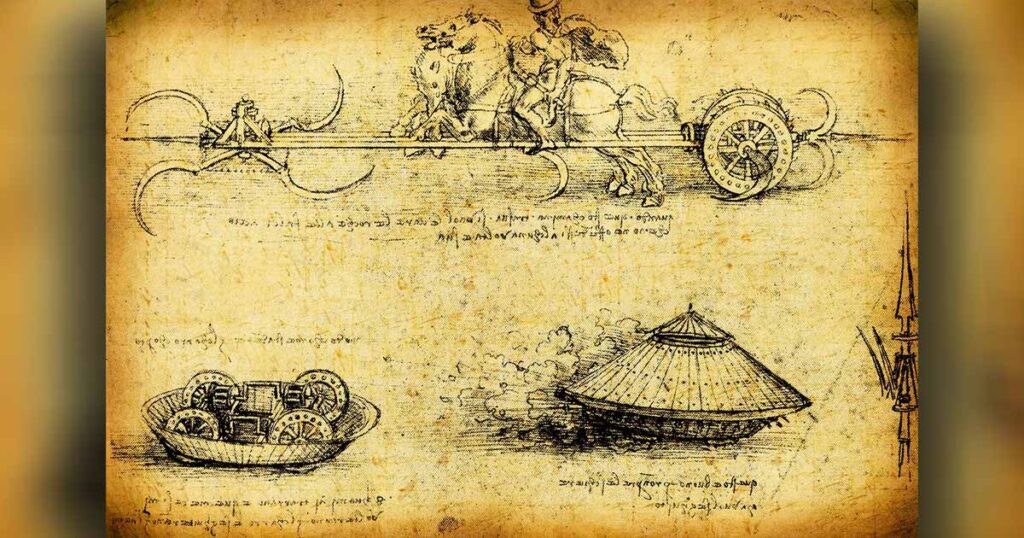
Although Leonardo da Vinci is predominantly remembered as a great artist, he was also a remarkable scientist and inventor. Many of his inventions were weird, some were wonderful, and more than a few were deadly. It is popular knowledge that Da Vinci designed some of the earliest flying machines; however, it is less well-known that he spent much of his time designing weapons of war. Leonardo da Vinci’s weapons were truly terrifying. So what drove a renowned artist to design such awful weapons of war and how effective were his designs?

da Vinci’s Vitruvian Man may be his most famous sketch, but he also drew designs for many weapons. (InnaBore / Adobe Stock )
The Measure of the Man: Who was Leonardo da Vinci?
First, a quick summary of Leonardo da Vinci’s life. Leonardo was born in Vinci, in the Republic of Florence in 1452. He came from relatively humble beginnings, the son of a notary and a lower class orphaned teenager. He trained under the painter and sculptor Andrea del Verrochio, beginning his career in Florence before moving on to Italy. He later spent time in Florence, Milan, and Rome, before dying in France at the age of 67 in 1519.
Leonardo da Vinci is remembered as one of the greatest artists of all time. He is most famous for his paintings the Mona Lisa and the Last Supper, while the Vitruvian Man is now a cultural icon. Da Vinci is also remembered as a technical genius. Although most of his designs were never manufactured due to limitations in metallurgy and engineering, their sheer conceptualization was impressive.
![]()
The iconic image of da Vinci’s Vitruvian Man, circa 1490, has been remixed a million times (Public Domain)
Leonardo da Vinci’s Weapons of War
Leonardo da Vinci took a scattershot approach to science. He made discoveries in anatomy, civil engineering, hydrodynamics, geology, optics, and tribology (friction, wear, lubrication etc), but never bothered to publish his findings. He did it out of sheer love of science and curiosity.
His approach to inventing things was similarly haphazard. He designed everything from fantastic flights of fancy (for the time) like flying machines and proto-computers, to more mundane inventions, like an automated bobbin winder. Leonardo da Vinci’s weapons were among his most outlandish designs.
It might seem strange that a man so in love with nature, beauty, and the natural world would spend his time designing weapons of death. However, Leonardo was a clever man. Renaissance Italy was made up of city-states that were perpetually at war with each other. Designing weapons provided Leonardo with a source of income, travel opportunities, and the chance to show off his scientific mind without the church knocking on his door.
Da Vinci’s Mobile Weapons
The Tank
Perhaps one of Da Vinci’s most famous weapon designs is his tank, especially after appearing in one of the popular Assassin’s Creed video games. His tank design resembled a cross of a spinning top toy and a UFO. It was a circular dish covered with angled steel plates that could be adjusted to protect it from enemy attack. The machine had an impressive number of light cannons mounted all around its circumference, allowing it to attack from any angle.
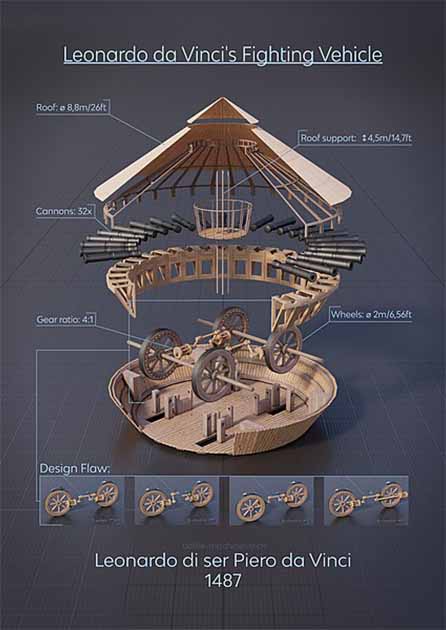
A model of da Vinci’s tank prototype created according to the original da Vinci drawing, with emphasis on proportions (Ľuboš Černák / CC BY SA 4.0)
Inside, it was operated by eight men who turned cranks and gears to develop momentum. The tank would have been truly formidable – if not for one major design flaw; it didn’t work. A prototype was actually built for the army to test, but they reportedly discovered that the drive train did not work. The gears were set up in such a way that the tank was completely immobile.
Such a seemingly rudimentary mistake seems odd for one as brilliant as Leonardo. Historians have claimed it was an act of self-sabotage, either to make sure no one copied his design or because he was secretly a pacifist.
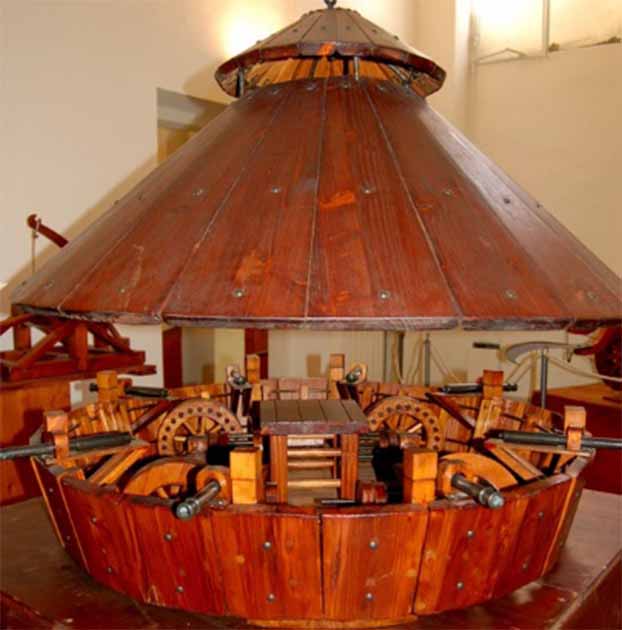
Full size model of da Vinci’s tank (Curious Expeditions / CC BY NC SA 2.0)
The Scythed Chariot
Many of Leonardo’s weapon designs never got past the drawing phase, and his scythed chariot is a great example. As a humanist and historian, Leonardo was fascinated by ancient history and ancient warfare. Many of his efforts were directed at refining those older designs. Romans and Persians had used scythed chariots with some success, and da Vinci attempted to improve on previous models.
Leonardo’s chariot was a rider on a horse dragging a machine of spinning blades. In some designs, the rider seems to be pulling one machine behind him but in another, he has spinning blades at his front and rear. Basically, imagine a human-sized lawnmower pulled by a horse and you get the grizzly idea.
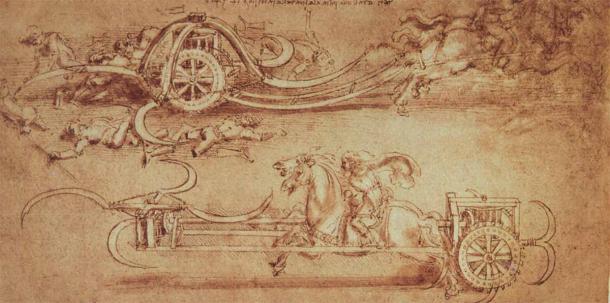
Leonardo da Vinci’s weapon design for a scythed chariot. It’s quite fascinating (Public Domain)
The Driverless Vehicle
Da Vinci also designed the first driverless vehicle. It was kind of a wind-up tricycle propelled by springs that rotated the wheels. At first, historians thought the vehicle was a flight of fancy until they realized the springs were leaf-shaped, which allowed them to actually build the design.
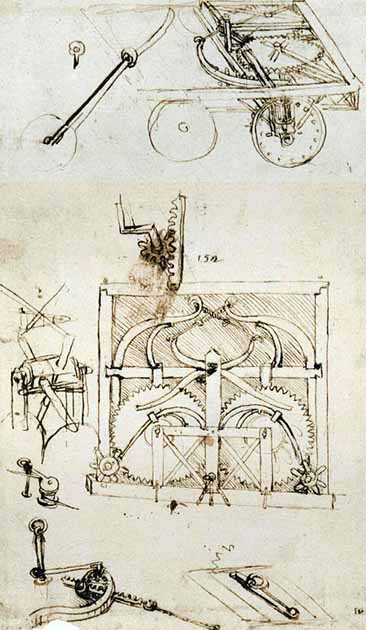
Da Vinci’s sketch for a self-propelled cart, or driverless vehicle, as we might call it today (Public Domain)
So how could a driverless vehicle be a weapon? Simply load it up with explosives and gunpowder and send it rolling towards your enemy. During that time period, they’d literally have no idea what hit them. Voila! The world’s first drone.
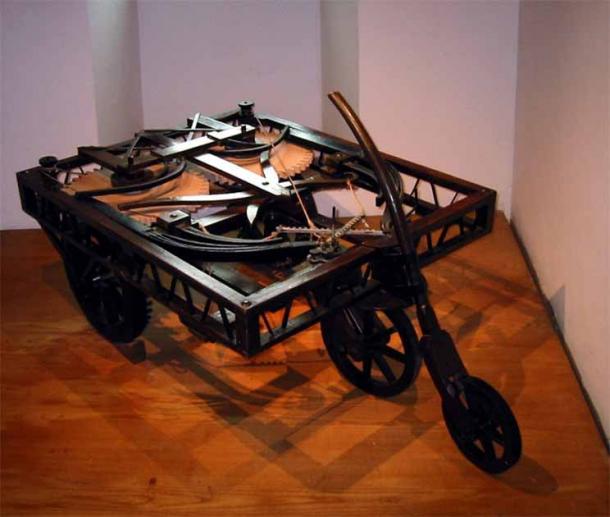
A reconstruction from da Vinci’s automobile sketch (Public Domain)
The Aerial Screw (Proto-helicopter)
Perhaps the most famous of Leonardo’s designs is his aerial screw. Often considered a predecessor to modern helicopter design, the aerial screw had rotating wings that created air resistance. The idea was that if resistance could be created, the machine and its pilot would be lifted from the ground.
Although not strictly a weapon in and of itself, it’s easy to see why any military would have been interested in fielding the aerial screw. As World War I would much later prove, aerial reconnaissance is an invaluable resource. However, as with da Vinci’s tank weapon design, modern scientists do not believe it would work.
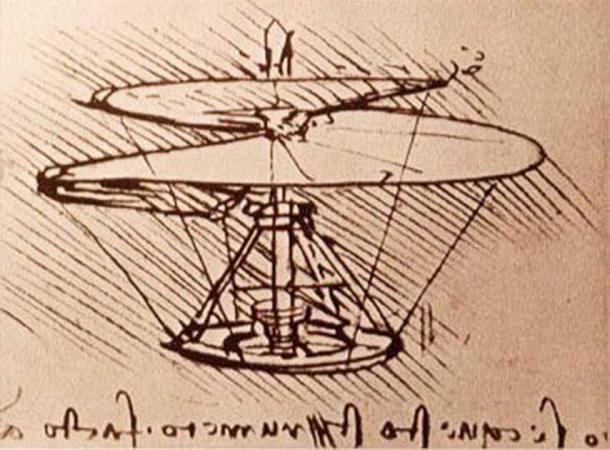
Detail from da Vinci’s aerial screw sketch. Often considered a proto-helicopter, its military application was clear (Public Domain)
Da Vinci’s Firearms
The Triple-Barreled Cannon
One of Leonardo da Vinci’s tamer weapons was his triple-barreled cannon. It will soon become apparent that Leonardo was fascinated by the idea of rapid-fire weaponry. In the case of the triple-barreled cannon, the barrels were designed to be fired quickly in sequence.
Da Vinci soon realized that the downside to his design was that the barrels overheated quickly. To fix this issue, the device was designed so that barrels could be easily removed and swapped out with fresh barrels that could be loaded and fired.
We know for a fact that this cannon was actually built. During the 20th century, Croatian children playing in a fort found one. In 2011, it was confirmed to be a genuine da Vinci design. Historians believe that Venetian forces had taken the cannon there during their conflict with the Turks.
Since the cannon was abandoned there, and no more have been found, we can only assume that the triple-barreled cannon was not one of his more popular designs. This cannon is however the only remaining example of a real-world weapon made from his designs.
The Rear-Loaded Cannon
Da Vinci designed an early breech-loading system where cannons could be loaded from the back, rather than the front. Before this, cannons had always been loaded from the front. Front-loaders had two major drawbacks. First, they were slow. Reloading from the front could take a far too long in a combat situation. Second, it was really, really dangerous. Front-loaders required putting one’s hands, arms, and head precisely where no sane person would want them.
If anything went slightly wrong, a cannoneer was likely to lose a limb at best, and their life at worst. If the cannon failed to fire, they were also left with a ticking time bomb. No one wanted to volunteer to put their head down the barrel to see what was wrong.
Being ahead of his time, da Vinci also suggested that barrels should be water-cooled. He claimed this could help prevent catastrophic malfunctions and improve accuracy. Water-cooled barrels would much later become commonplace. For example, in WW2 the M1917 Browning Machine used a water jacket to keep its barrel cool.
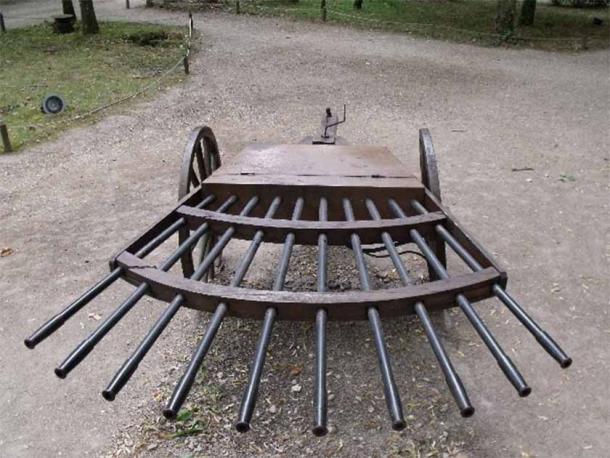
A full-size model of one of da Vinci’s weapons: a rear-loading cannon. The Chateau du Clos-Luce, da Vinci’s home in his final years, has many of da Vinci’s weapon designs on display (Elliot Brown / CC BY 2.0)
The 33-Barreled Organ of Death
Da Vinci’s first two firearms were pretty sensible, but things are about to get a little wild. The 33- barreled organ consisted of 33 cannons arranged in rows in a fan shape. Da Vinci’s aim was to combat two major problems with conventional cannons: their slow rate of fire and their inaccuracy.
When reloading is slow, lost time can be catastrophic. Da Vinci’s barreled organ fired several cannons at once. When that row was being reloaded, the next row could be fired, allowing rapid-fire shooting.
Furthermore, the fan shape of the cannons allowed a spread that meant you were likely to hit at least something with each volley. The wide field of fire made it an ideal weapon against a mass of advancing troops. It was also designed to be lightweight and came with wheels, meaning it would have been easy to move around the battlefield.
There is no evidence that a 33-barrelled organ was ever actually produced. Da Vinci later designed a smaller 11-barreled version but this too seems to have stayed on the drawing table.
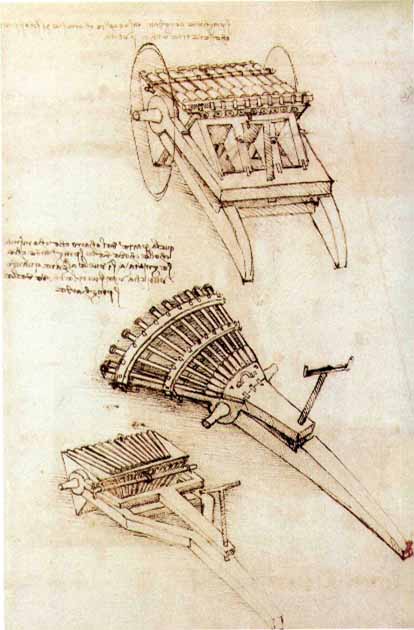
Several of da Vinci’s weapons were variations of cannons, like these ‘organ guns’ (Public Domain)
The Giant Crossbow
What’s better than a normal crossbow? A giant one! Leonardo’s giant crossbow was designed to be the ultimate siege device. It was intended to fire incendiary ammunition, giant bolts, and even boulders at enemy defenses.
It was more than 25 meters wide and came on six wheels, so it could be moved around a battlefield. It was crank-powered, meaning only one soldier was needed to pull back the projectile and pin it ready for release.
This was another design doomed for failure. Da Vinci had designed it as a cheap alternative to expensive firearms. However, it didn’t really do anything those firearms couldn’t; guns and cannons were just the all-around better weapons.
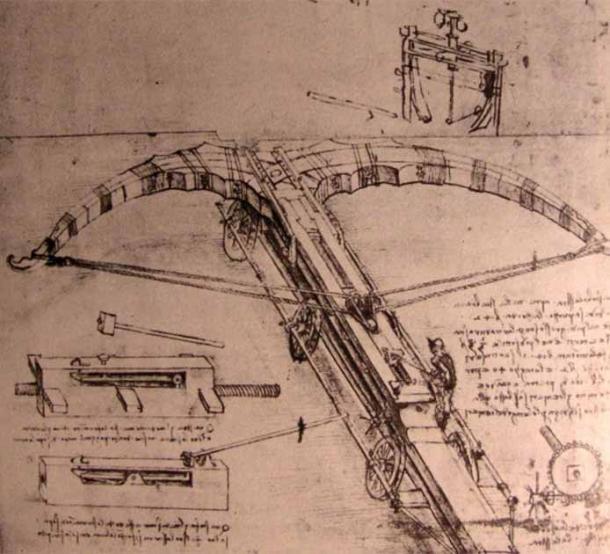
Leonardo da Vinci’s largest weapon design was a giant crossbow. Note the adult towards the rear loading the weapon (Public Domain)
The Machine Gun Crossbow
Leonardo took one last stab at an improved crossbow design with his machine gun crossbow. It was a wooden wheel with crossbows attached, which were then fired in succession. The wheel was treadmill operated. A man or group would walk on the outside of the wheel rotating it, while others reloaded the crossbows.
Although it sounded impressive, it wasn’t one of Leonardo’s better designs; it was next to impossible to aim and no more efficient than if you just gave each man his own crossbow. This one also never saw production.
Engineering Marvels
The Portable Bridge
Not all of da Vinci’s military-sponsored inventions were weapons, some took a more logistics-based approach. Da Vinci designed several types of portable bridges. Some were revolving bridges with interlocking beams fastened to a pylon that swung around to shore. They were designed to be light, strong, and portable.
In warfare, it isn’t uncommon for troops to need to cross rivers and waterways that are otherwise blocking their way. This can cause serious delays that lead to bottlenecks and make enemy ambushes easy. Likewise, bridges are often a primary target when trying to block supply routes. All of these factors make a portable bridge invaluable and they are still readily used in warfare today.
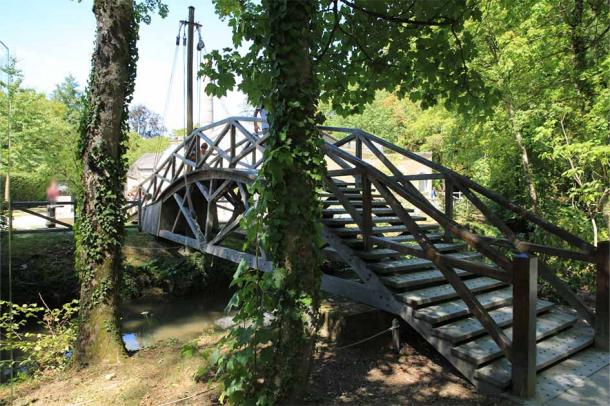
Model of transportable bridge, chateau Clos Lucé (Als33120 / CC BY SA 4.0)
A Case of Self-Sabotage?
On top of the above, da Vinci designed various other weapons, including steam-powered cannons and catapults that could lob stones and incendiary devices. Unfortunately or perhaps luckily most of Leonardo’s designs never left the drawing board – but why was this?
Many of his designs were ahead of their time, relying on metallurgy and engineering which hadn’t been invented yet. But this isn’t the whole story. Engineers and historians who have looked at Leonardo da Vinci’s weapons designs claim many of them come with built-in faults. For example, the tank’s gear design meant it couldn’t move. It has been theorized that da Vinci was secretly a pacifist and sabotaged his own designs. He made them plausible enough to receive funding but ensured they would never go into mass production.
Devious Da Vinci?
How did da Vinci get away with this? The enormous egos of his clients. The kind of men who da Vinci worked for were more than happy to throw their money at the renowned da Vinci, if it made them look powerful and menacing. Furthermore, he kept on their good side by arranging amazing spectacles based on his patrons’ previous military victories. In 1518, he curated a festival in France celebrating Francois I’s military achievements. These grandiose reenactments only helped bolster Leonardo’s reputation.
If da Vinci indeed sabotaged his own designs, would that make him a con man and a charlatan? Perhaps. However, the money he made from those designs helped pay for his artistic and scientific endeavors. He took money from the rich and powerful, in order to do what he loved while avoiding bloodshed. It’s hard to judge him for that.